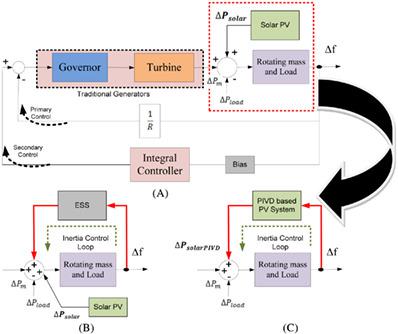当前位置:
X-MOL 学术
›
Int. Trans. Electr. Energy Syst.
›
论文详情
Our official English website, www.x-mol.net, welcomes your feedback! (Note: you will need to create a separate account there.)
Investigating the frequency fault ride through capability of solar photovoltaic system: Replacing battery via virtual inertia reserve
International Transactions on Electrical Energy Systems ( IF 2.3 ) Pub Date : 2021-01-20 , DOI: 10.1002/2050-7038.12791 Pranjal Saxena 1 , Navdeep Singh 1 , Ashok Kumar Pandey 1
International Transactions on Electrical Energy Systems ( IF 2.3 ) Pub Date : 2021-01-20 , DOI: 10.1002/2050-7038.12791 Pranjal Saxena 1 , Navdeep Singh 1 , Ashok Kumar Pandey 1
Affiliation

|
The low voltage ride through (LVRT) capability is an important aspect of the microgrid system, dominated by renewable energy sources (RES). Earlier studies investigate the LVRT capabilities of microgrids but ignore their frequency stability during and after the fault scenario. This paper fills this gap by investigating the frequency fault ride through (FFRT) capability of photovoltaic (PV) based microgrid model and suggests a novel PI‐based virtual damping (PIVD) controller for enhancing the dynamic performance. This controller tracks the frequency error and de‐loads the solar power in the same proportion. This de‐loading creates useful virtual inertia reserve (VIR), which replaces the role of battery storage by stabilizing the grid during the contingency period. To validate the effectiveness, a microgrid assisted with the PIVD controller is simulated in MATLAB and its frequency performance is compared with pre‐existing conventional and ESS models. The comparative results confirm that the proposed model is capable of riding through the severe fault scenario, with the least possible frequency deviation.
中文翻译:

调查频率故障穿越太阳能光伏系统的能力:通过虚拟惯性储备更换电池
低压穿越(LVRT)能力是微电网系统的重要方面,由可再生能源(RES)主导。较早的研究调查了微电网的LVRT功能,但忽略了其在故障场景期间和之后的频率稳定性。本文通过研究基于光伏(PV)的微电网模型的频率故障穿越能力(FFRT)来填补这一空白,并提出了一种新颖的基于PI的虚拟阻尼(PIVD)控制器来增强动态性能。该控制器跟踪频率误差并以相同比例卸载太阳能。这种卸载可创建有用的虚拟惯性储备(VIR),通过在应急期间稳定电网来替代电池存储的作用。为了验证有效性,在MATLAB中模拟了带有PIVD控制器的微电网,并将其频率性能与现有的常规模型和ESS模型进行了比较。比较结果证实,所提出的模型能够克服严重的故障情况,并且频率偏差最小。
更新日期:2021-03-02
中文翻译:

调查频率故障穿越太阳能光伏系统的能力:通过虚拟惯性储备更换电池
低压穿越(LVRT)能力是微电网系统的重要方面,由可再生能源(RES)主导。较早的研究调查了微电网的LVRT功能,但忽略了其在故障场景期间和之后的频率稳定性。本文通过研究基于光伏(PV)的微电网模型的频率故障穿越能力(FFRT)来填补这一空白,并提出了一种新颖的基于PI的虚拟阻尼(PIVD)控制器来增强动态性能。该控制器跟踪频率误差并以相同比例卸载太阳能。这种卸载可创建有用的虚拟惯性储备(VIR),通过在应急期间稳定电网来替代电池存储的作用。为了验证有效性,在MATLAB中模拟了带有PIVD控制器的微电网,并将其频率性能与现有的常规模型和ESS模型进行了比较。比较结果证实,所提出的模型能够克服严重的故障情况,并且频率偏差最小。


























 京公网安备 11010802027423号
京公网安备 11010802027423号